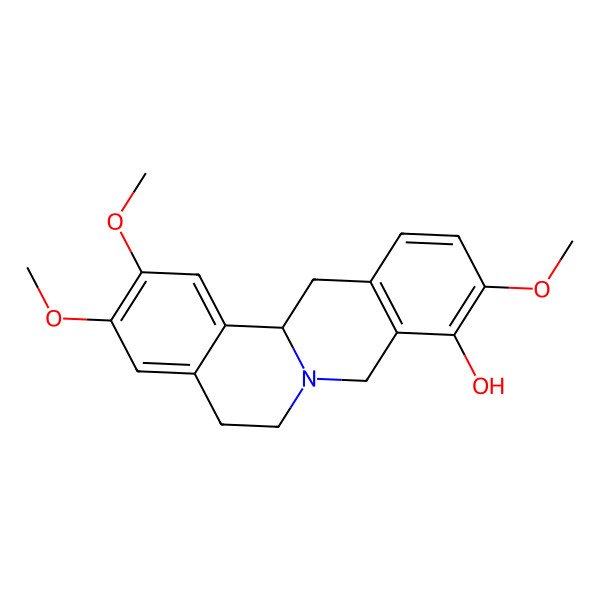Tetrahydropalmatrubine
| Internal ID | fe5e673f-37e3-4fc1-8310-6889d67cdf5f |
| Taxonomy | Alkaloids and derivatives > Protoberberine alkaloids and derivatives |
| IUPAC Name | 2,3,10-trimethoxy-6,8,13,13a-tetrahydro-5H-isoquinolino[2,1-b]isoquinolin-9-ol |
| SMILES (Canonical) | COC1=C(C2=C(CC3C4=CC(=C(C=C4CCN3C2)OC)OC)C=C1)O |
| SMILES (Isomeric) | COC1=C(C2=C(CC3C4=CC(=C(C=C4CCN3C2)OC)OC)C=C1)O |
| InChI | InChI=1S/C20H23NO4/c1-23-17-5-4-12-8-16-14-10-19(25-3)18(24-2)9-13(14)6-7-21(16)11-15(12)20(17)22/h4-5,9-10,16,22H,6-8,11H2,1-3H3 |
| InChI Key | DKBYSDUFSXFXMP-UHFFFAOYSA-N |
| Popularity | 1 reference in papers |
| Molecular Formula | C20H23NO4 |
| Molecular Weight | 341.40 g/mol |
| Exact Mass | 341.16270821 g/mol |
| Topological Polar Surface Area (TPSA) | 51.20 Ų |
| XlogP | 2.90 |
| 2,3,10-Trimethoxy-6,8,13,13a-tetrahydro-5H-isoquinolino[3,2-a]isoquinolin-9-ol |
| 32154-71-5 |
| 7762-76-7 |
| (-)-Tetrahydropalmatrubine |
| (1)-Tetrahydropalmatrubine |
| SCHEMBL12904352 |
| DTXSID50954024 |
| BDBM50424076 |
| 2,3,10-trimethoxy-6,8,13,13a-tetrahydro-5H-isoquinolino[2,1-b]isoquinolin-9-ol |
| 2,3,10-Trimethoxy-5,6,8,13-tetrahydro-13aH-dibenzo[a,g]quinolizine-9-ol |
| There are more than 10 synonyms. If you wish to see them all click here. |

| Target | Value | Probability (raw) | Probability (%) |
|---|---|---|---|
| No predicted properties yet! | |||
Proven Targets:
| CHEMBL ID | UniProt ID | Name | Min activity | Assay type | Source |
|---|---|---|---|---|---|
| CHEMBL4081 | P13726 | Coagulation factor III |
187.26 nM 187.26 nM |
IC50 IC50 |
via Super-PRED
PMID: 23199480 |
| CHEMBL2056 | P21728 | Dopamine D1 receptor |
443 nM 410 nM |
Ki IC50 |
via Super-PRED
via Super-PRED |
Predicted Targets (via Super-PRED):
| CHEMBL ID | UniProt ID | Name | Probability | Model accuracy |
|---|---|---|---|---|
| CHEMBL3251 | P19838 | Nuclear factor NF-kappa-B p105 subunit | 98.36% | 96.09% |
| CHEMBL217 | P14416 | Dopamine D2 receptor | 96.27% | 95.62% |
| CHEMBL241 | Q14432 | Phosphodiesterase 3A | 94.51% | 92.94% |
| CHEMBL2041 | P07949 | Tyrosine-protein kinase receptor RET | 94.34% | 91.79% |
| CHEMBL1293249 | Q13887 | Kruppel-like factor 5 | 92.55% | 86.33% |
| CHEMBL4261 | Q16665 | Hypoxia-inducible factor 1 alpha | 92.33% | 85.14% |
| CHEMBL5619 | P27695 | DNA-(apurinic or apyrimidinic site) lyase | 91.85% | 91.11% |
| CHEMBL5608 | Q16288 | NT-3 growth factor receptor | 90.52% | 95.89% |
| CHEMBL4203 | Q9HAZ1 | Dual specificity protein kinase CLK4 | 89.52% | 94.45% |
| CHEMBL2535 | P11166 | Glucose transporter | 89.13% | 98.75% |
| CHEMBL5697 | Q9GZT9 | Egl nine homolog 1 | 88.97% | 93.40% |
| CHEMBL225 | P28335 | Serotonin 2c (5-HT2c) receptor | 88.95% | 89.62% |
| CHEMBL2581 | P07339 | Cathepsin D | 88.26% | 98.95% |
| CHEMBL3438 | Q05513 | Protein kinase C zeta | 87.82% | 88.48% |
| CHEMBL5747 | Q92793 | CREB-binding protein | 87.45% | 95.12% |
| CHEMBL1907603 | Q05586 | Glutamate NMDA receptor; GRIN1/GRIN2B | 86.67% | 95.89% |
| CHEMBL3108638 | O15164 | Transcription intermediary factor 1-alpha | 86.60% | 95.56% |
| CHEMBL5845 | P23415 | Glycine receptor subunit alpha-1 | 84.35% | 90.71% |
| CHEMBL3192 | Q9BY41 | Histone deacetylase 8 | 82.92% | 93.99% |
| CHEMBL2069156 | Q14145 | Kelch-like ECH-associated protein 1 | 82.37% | 82.38% |
| CHEMBL4208 | P20618 | Proteasome component C5 | 82.09% | 90.00% |
| CHEMBL4681 | P42330 | Aldo-keto-reductase family 1 member C3 | 81.93% | 89.05% |
| CHEMBL2146302 | O94925 | Glutaminase kidney isoform, mitochondrial | 81.09% | 100.00% |
| CHEMBL3060 | Q9Y345 | Glycine transporter 2 | 80.44% | 99.17% |
| CHEMBL5469 | Q14289 | Protein tyrosine kinase 2 beta | 80.09% | 91.03% |
Below are displayed all the plants proven (via scientific papers) to contain this
compound!
To see more specific details click the taxa you are interested in.
To see more specific details click the taxa you are interested in.
| Corydalis saxicola |
| Phellodendron amurense |
| Phellodendron chinense |
| Zanthoxylum integrifoliolum |
| PubChem | 453215 |
| NPASS | NPC276588 |
| ChEMBL | CHEMBL2314745 |
| LOTUS | LTS0252503 |
| wikiData | Q82933028 |